The Internet is broken…
…literally.
Millions of links become broken every day as hosting expires, sites mess up when they migrate, and typing mistakes occur.
All of those events create one of the most consistent opportunities for SEO link building.
Broken link building isn’t new; in fact, it’s been around for years.
It’s a tactic that will never be exhausted because the Internet will always have new broken links.
Here’s what broken link building is in a nutshell:
If you find a broken link on a website, you can contact the owner. Since you did him/her a small favor of pointing out a broken link, they might do you the favor of including a link to your website. You can even offer a replacement link when appropriate.
It’s very simple: finding broken links is your in.
This tactic relies on the principle of reciprocity—one of the six principles of influence, according to Cialdini:
The principle of reciprocity states that when you do something nice for another person, they are much more likely to pay it back by doing you a favor of a similar size.
There are a few guides to broken link building available, and I even covered the topic in my advanced guide to link building. But most of those guides are at least a few years old, so I wanted to give you an up-to-date guide with modern twists on the old tactic.
Bulk is better
There is one key to broken link building that you must keep in mind if you’re going to use this tactic successfully: broken link building must be scaled.
Unlike tactics like email outreach or some other types of promotion, broken link building doesn’t get an amazing success rate. In most niches, you’ll get around 5 to 10 links for every 100 emails you send.
It’s decent but not great.
If you’re only sending a few emails here and there, you won’t ever see real results from this tactic.
You need to approach it the way I’m going to show you in this article and use the right tools to scale it.
It’s possible, and necessary, to find hundreds of broken link opportunities at once as well as to minimize your time spent emailing site owners.
This way, you can feasibly send over 100 link requests a day (without spamming) and acquire a decent number of links. If you do this on a fairly regular basis, this tactic alone can be very effective in your overall link building campaign.
Tools that will help you
As I said, you will need tools for this tactic.
Out of many available options, including a few paid ones, I’ve picked four that can provide you with everything you need.
Tool #1 – Check My Links Chrome extension: If you’re ever in need of a tool that can quickly check a page for broken links, this is it.
Once installed, it will appear as a little checkmark icon beside your address bar. When you click it, it will start scanning all links on the page. If a link is broken, it will be highlighted in red, and the error will be shown right beside the text (e.g., “404”).

The one drawback of this tool is that you still need to scroll through the page to find the red highlighted links. If you could simply copy all the broken links by clicking a button, it would be perfect.
Tool #2 – Domain hunter plus: This extension is an alternative to Check My Links. It works similarly. You click the icon, and the tool scans the links on the page.
The difference is that this extension doesn’t stop at just finding broken links. It also checks to see if the broken link domain is available for registration as well as how many links point to that domain.

If you do find a domain available to register, you could register it and then redirect the pages with links to them however you wish.
Alternatively, you could email everyone who links to that domain (could be hundreds or thousands of sites) and ask them to link to you instead.
One warning: I’ve found this plugin to be hit and miss. On occasion, it will say that a link is broken, but when you actually test it, it works. Just be sure to double check your results once in a while.
Tool #3 – Canned responses Gmail feature: A huge component of broken link building is emailing website owners. In order to do that efficiently, you will need to make use of templates.
Gmail has a great built-in feature called “Canned Responses.” It’s just not activated by default.
To activate it, click the little gear icon at the top right of your mail box, and click “Settings”:

Now, click on the “Labs” menu option.

This will bring up several experimental features Google has released. Some of them are pretty useful.
The Canned Responses Lab should be on the list of recommended labs, fairly high up.
Once you find it, click on the radio button to enable it:

Make sure that you scroll down to the bottom of the page and click “save changes.” After you do, Gmail will automatically reload with the feature enabled.
The next time you type in an outreach email/template into a blank email, you have the option of clicking the little down arrow in the bottom right-hand corner (shown below) and choosing“Canned responses”.
Then, click on “New canned response,” which will prompt you to enter a name:

Once you’ve done that, you’ve saved that template.
When you open a new blank email, you can click that same arrow in the bottom right and highlight the Canned Responses option. You’ll see the name of the template you just entered.
When you click it, it will paste that previously written message with the name of the template in the subject line:

I’ll go into more detail on sending emails later, but this, or any other template extension, is very useful.
Tool #4 – Xenu’s Link Sleuth: If you’re going to do broken link building at scale, you need this tool. It’s a free and amazingly robust tool that allows you to check all the links of up to hundreds of pages, all at once.
You’ll need to know how to use the basic functions of the tool before moving on in this article, so let me quickly show you the main features before we get started.
The “File” menu option is what you’ll use the most.
You can either check a single URL (“Check URL”), or you can check a large list of URLs all at once (“Check URL List”). There are times and places for both features. If you use the list option, you’ll need to upload a text file of URLs, with one on each line.
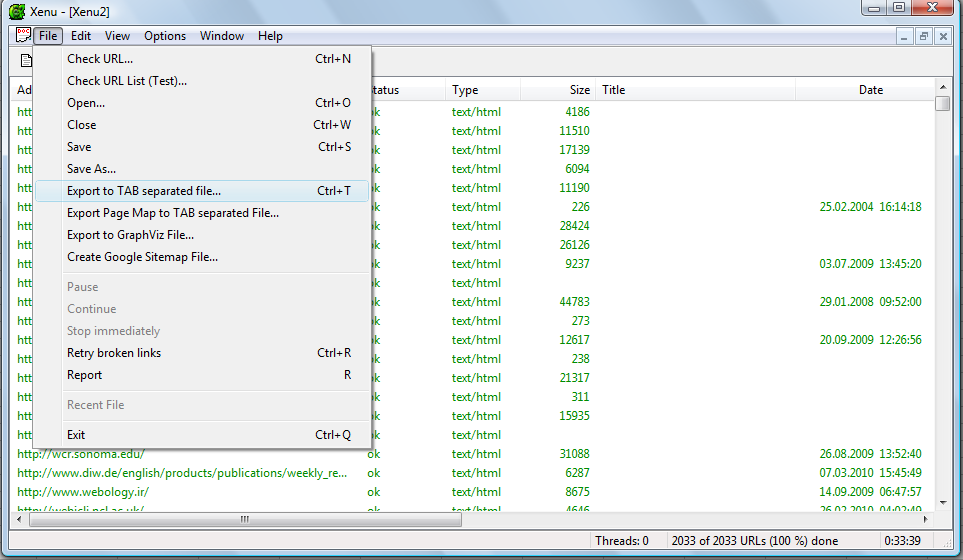
The results you’ll get will depend heavily on the settings you choose.
When you go to “Options > Preferences”, you’ll see the following window:

You can play around with the settings under “Report,” but you should have at least the first four settings checked.
The most important setting is the “maximum level” setting.
Say you were checking Quicksprout.com for broken links. If you just wanted to scan the links on the homepage, you would put a maximum level of “1”. They are “1” click away.
If you also wanted to check the links on all the pages that the homepage is linked to, you would set the level to “2”. Clearly, the higher the maximum level, the more URLs it will scan.
If you’re looking for links on a specific page (because it’s highly authoritative/relevant), you’ll want to keep this number low.
If you’re looking for all sorts of opportunities, you can set it high (999 is the highest).
If you’re a bit confused, don’t worry. I’ll give you more detail about this feature later in this post.
Finally, there’s the parallel threads option. The higher it is, the more of your computer resources the software will use, but it will run the query faster. I recommend running at least 20 threads.
Once you run a report (status in bottom right), you’ll see a list of results. Green results are working links, while red ones are errors of some kind.
There are different “status” labels for different error codes (see them here):
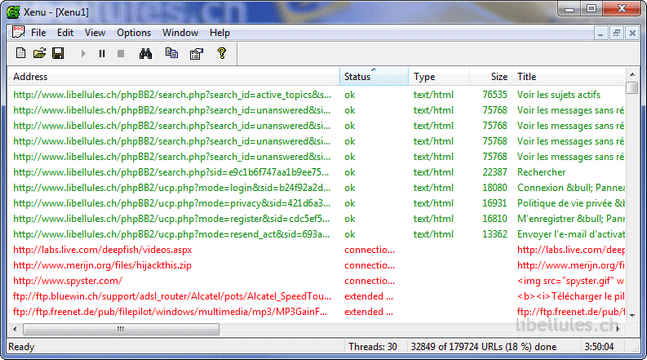
You can also use the “Export” option under the “File” menu to generate a spreadsheet of the results. If you have thousands of results, this makes it much easier to sort through them.
Step 1: It starts with your targets
The first step in broken link building is to find broken links.
There are many ways to do this, but I’m going to show you three of the most effective.
Tactic #1 – Pick a particular domain: Chances are there’re a few authority sites in your niche that you’re dying to get a link from, but maybe you can’t find your “in.” This is a perfect opportunity for broken link building.
Let’s say you wanted to find broken links on Quick Sprout.
Open Xenu, pick the “Check URL…” option in the file menu, and enter either quicksprout.com or quicksprout.com/blog as the starting point in the text box.
There are a few other things you also need to do…
Check the “check external links” box. Now Xenu will check both internal and external links.
Then, click “More options…” in the bottom left, which will bring up the same panel I showed you before.
For this purpose, you want to crawl as many pages on the site as possible, so pick a high “maximum depth.”
Once you’re ready, click “OK” twice to start the scan.
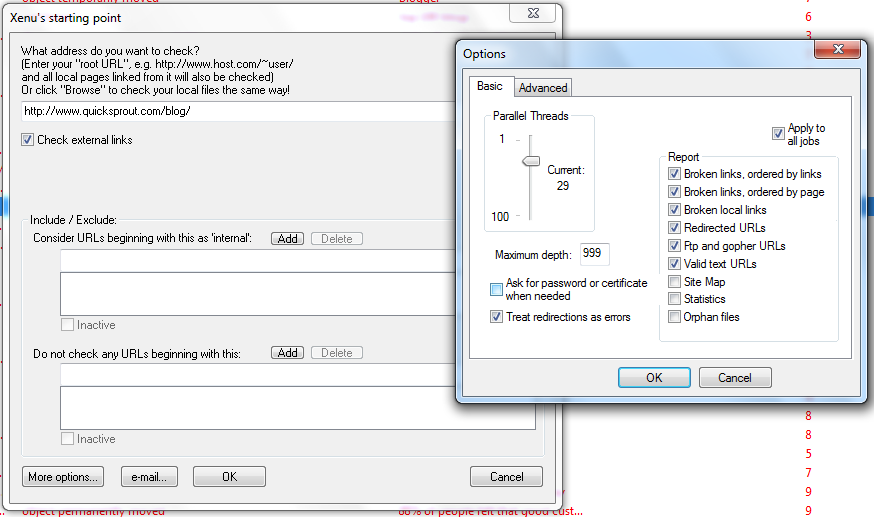
After a few minutes (depending on your computer speed), you’ll get a report.
I recommend sorting the results by “level.” The lower the level, the closer the dead link is to the starting point. If you email someone about a page on their site from 10 years ago, they probably won’t care. But if it’s only a few months old, they probably want to keep it updated.

Then you need to find the link on the page and verify that it’s actually broken (Xenu is wrong sometimes).
Right-click on any of the broken URLs, and choose “URL Properties.” This will bring up a small window (shown above), where you can see which pages have the dead link on them in the bottom section of the pop-up.
Tactic #2 – Find sites in your niche: This tactic is mainly for finding relevant broken links on sites in your niche.
Combine keywords in your niche with search strings in order to find pages that have lots of links on them. The more links on a page, the more likely you are to find broken ones.
Here are some search strings you can use, but you’re free to get creative as well:
- keyword + “resources”
- keyword + intitle:resources
- keyword + intitle:blogroll
- keyword + “blogroll”
- site:.gov keyword + “links”
- site:.edu keyword + “recommended sites”
- keyword + “related links”
You can proceed from here in two different ways.
The first method is labor-intensive.
Click promising results from your searches, and check each page for broken links using one of the extensions I showed you before.
For example, if I had a design site, I could search for:
intitle:blogroll design
One of the first pages I clicked had several dead links according to a quick Domain Hunter scan:

You could either contact the site owner right away or just add this URL and its broken links to a spreadsheet.
While that method will work, it’s slow.
The better way to do it is to use Scrapebox. It allows you to scrape hundreds or thousands of URLs from search results based on different footprints (search strings) all at once. However, it is a paid tool, and you’ll also need to buy proxies.

Obviously, I’m in favor of the bulk method for finding broken links, but it’s up to you.
When you get massive list of URLs that you want to check for broken links, plug the entire list into Xenu. However, this time you want to limit the link depth to 1 or 2, so you only find broken links on those pages that you found (or closely related ones).
If you set the depth to 3, you’ll get many more links, but you’ll notice that they won’t all be relevant to your initial keyword.
Tactic #3 – Search by keyword: The final option is to search for a specific keyword that you’re targeting.
For example, say I created a post on the top podcasting tools. Now, I want to build links to it using broken link building.
I can search Google for “top podcasting tools,” and then visit all the top results:
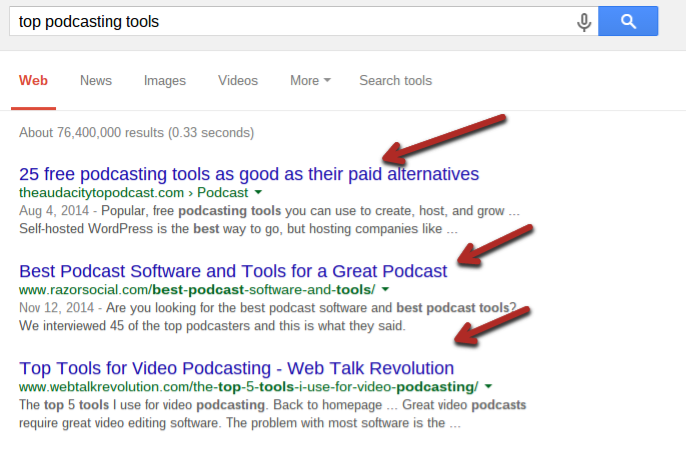
The top results usually have the highest number of links pointing to them, which is important.
Next, plug in any of these URLs, one at a time, into a link database tool such as Ahrefs:
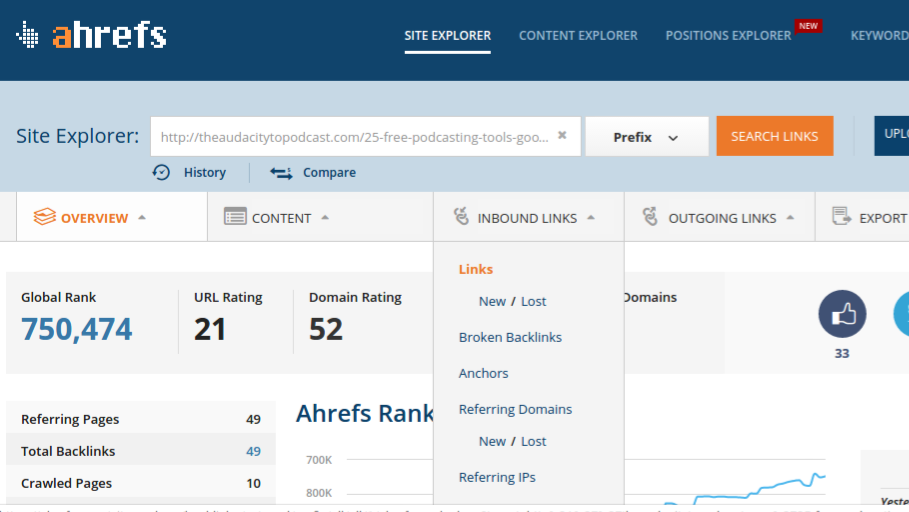
Hover over “inbound links,” and then click on “links,” which will bring up a massive list of pages that linked to those articles about podcasting tools.
You will need a paid account to get any real results using this method.
Now, scan all of the pages that link to the article for broken links. If they do have a broken link, let them know about it and suggest also adding a link to your article.
If your new article is great, you have a decent shot at getting a link.

Again, you can check these one at a time with a free extension:

Or you can export them into Xenu. Again, use a shallow link depth of 1 or 2.
In the case above, there are several similar broken links because the author forgot the “https://” part of the link. Since it’s a fairly recent article, and there are several broken links, your chances of getting a link go way up (because you helped out more).
Step 2: Methodical broken link building involves content creation
Depending on which of the tactics from step 1 you choose to use (you can use more than one), you will need some content.
Method 1 – Create content first: The most basic option is to create content according to your content schedule and then go hunting for relevant pages that have broken backlinks.
This is what I showed you with tactic #3 of step 1.
It’s a good method but not the best because you’re making a somewhat unrelated request.
You’re finding dead links and then basically saying: “My article is also related to your page’s topic, so do you mind adding a link?”
Some will go for this, of course, but there’s an alternative option.
What if you could instead email them saying: “This link is broken on your page, but luckily, I have a better version of it on my site. Here’s the link…”
All of a sudden, it makes a ton of sense for them to add your link instead of having to track down a replacement.
The only problem is that your article won’t always be a perfect replacement. That’s where method 2 comes in…
Method 2 – See how many sites link to a broken URL: If one site has linked to a broken URL, chances are that others have as well.
So when you come across a broken link, check how many backlinks point to the page.
For example, while looking at a few podcasting articles, I found a broken link on this page that pointed to: https://www.podcastingpassion.com/

That site is clearly dead, and it was flagged by Check My Links for me.
When I plugged that broken URL into Ahrefs, I saw that it has 12 linking domains for 45 total backlinks:
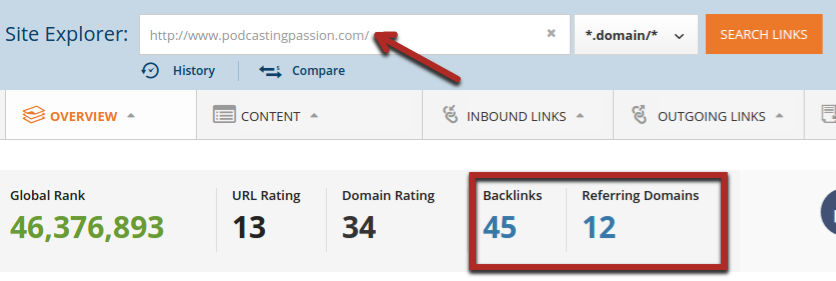
Honestly, that’s not great, but it will do for the purposes of this example.
Once you find a broken URL that has many links, look it up using archive.org. Just type in the URL into the search bar, and you can see what the page used to look like when it was active.
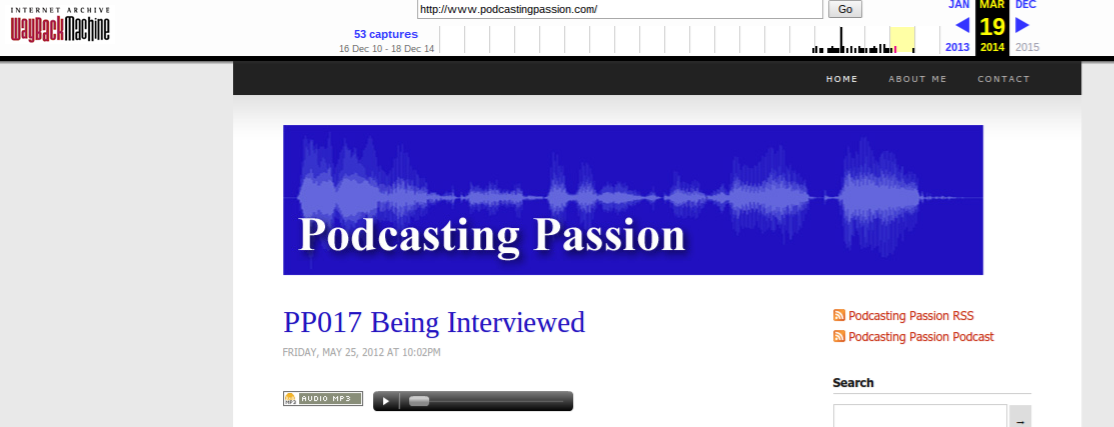
Now, re-create the page (same topic), but make it better so that the linker has a good incentive to link to your new page.
Creating content that is a perfect substitute for a broken page will obviously take more time, but it will get you a higher conversion rate.
Step 3: Engage targets and get your links
After the first two steps, you should have a large list of URLs with broken links as well as at least a somewhat relevant link on your site that you can offer as a replacement.
The last major part is to contact the webmasters and let them know about the dead links.
Find the right contact information: Some sites make it easier to find contact information than others. Avoid sending emails to generic “support” email addresses or using generic contact forms. In my experience, those have the lowest conversion rate.
If it’s a blog that has the broken link, the best way by far is to sign up for their email list. That way, you’ll immediately get an email from an email address that is actively monitored.
Most blogs have signup forms in the header or sidebar of the blog:
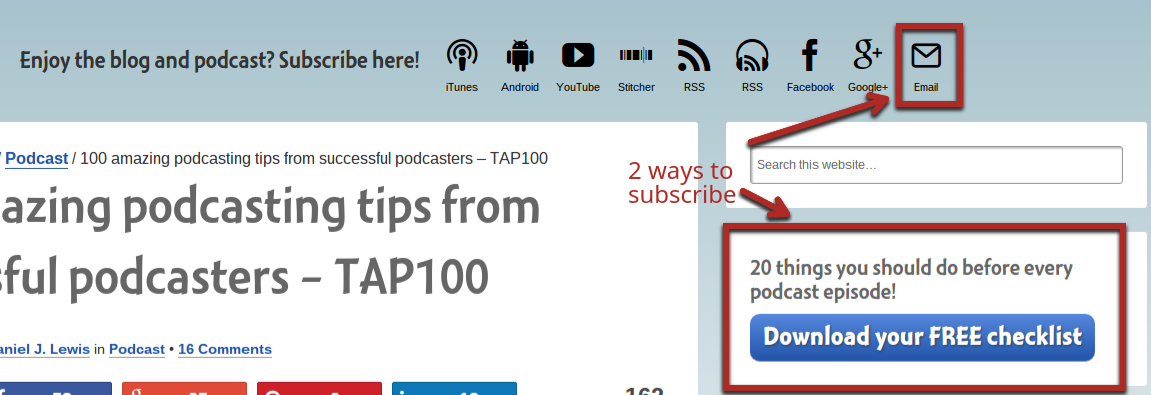
Blogs are the easiest to find contact information for.
The hardest ones are .edu and .gov sites.
There are no rules that apply 100% of the time. Finding the right contact information is a process that you will have to learn through experience.
For example, let’s say I was looking for a link on this podcast page on wvu.edu:

The first place where I would look is a department specific email. Usually you can find this by scrolling down to the bottom:

If you’re comfortable on the phone, that’s also a very good option.
But not all sites or sections of sites will have that. Next, look at the About page for the section, which is usually located near the top:
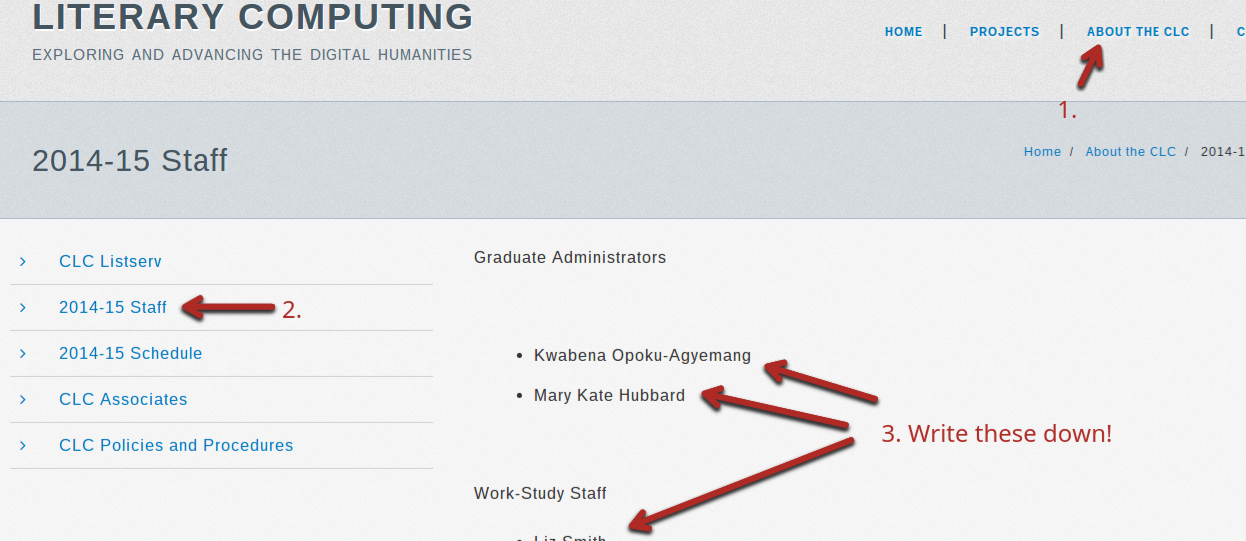
We can see only three names there.
To try to find their contact information, check the school’s directory, which will be at the very top or bottom:

Then, search for each name.
If there are many people listed, try to find a project manager or someone who is likely to update web pages.

In my case, I actually couldn’t find any matches for those three staff members. But if I did, I would use the email and telephone number from the search.
As the last resort, look at the footer for the websites for a feedback form link:

This usually sends an email to the IT department. You can ask them to forward your email to the appropriate department if they can’t help you.
Keys to a successful outreach email: Once you have your contact information, it’s time to craft your outreach email.
In general, there are four things to keep in mind:
- Personalization – Whenever possible, start your email with a name (no “Dear Sir”). If you can’t find a name, just start with “Hi” or “Hello.” While we will be using a template, try to add a line or two at the start that is customized for each site (e.g., I loved your article on X last month).
- Keep it short – The shorter your email, the more likely that your target will read the whole thing and understand what you’re asking for. Be as concise as possible.
- Be professional – Write with proper grammar, and don’t be too pushy. While it’s okay to follow up once or twice, don’t spam anyone.
- Be polite – Politeness goes a long way. Understand that you’re asking for a favor (albeit a small one), so don’t make demands or insult anyone.
Here’s a template you can use:
Subject: Quick feedback – dead resource on your site
Hi [name],
I was recently researching (topic) for an article I was writing and came across this page on your site: (URL).
I found it very useful, but there are a few dead links on the page:
- (link #1)
- (link #2)
- …
I came across a few other great resources during my research, which you could put in their place:
- (link #1)
- (link #2)
- …
I think they would help anyone in the future looking for more information about (topic).
If you do update the page, I’d appreciate it if you would consider including a link to my article. It’s about (description). I think your visitors would also appreciate it. Here’s the link if you’re interested:
(Your URL)
Thank you for your time,
(Your name)
Once you have your template, pop it into canned responses like I showed you earlier so that you can quickly put it into a new email.
A final note: While templates are needed for efficiency, customize them as much as you can for each email you send. If you can add a sentence about the site you’re emailing about, it will improve your conversion rates.
Step 4: Track your results
Now you know how broken link building works and how you can use it to acquire some pretty nice links to your content.
It’s important to stay organized and track your results for three reasons:
- So you don’t waste time emailing the same sites
- So you can calculate ROI
- So you can improve your success rate (track which templates do better than others)
Sometimes, you will get an email response saying that your link has been added. However, sometimes you won’t, and it’s up to you to find out if the link has been added.
If you do get an email back, just highlight the URL or make a note of it on your spreadsheet. But first, make sure you check to see that the link is actually there and has been added correctly.
Monitoring method #1 – Confirm links by visiting the page manually: While you could create a custom tool to check pages for your links if you have programming skills, you can always use this basic method.
Go to the page that is supposed to have your link on it. Right-click anywhere on the page and select “View page source”:
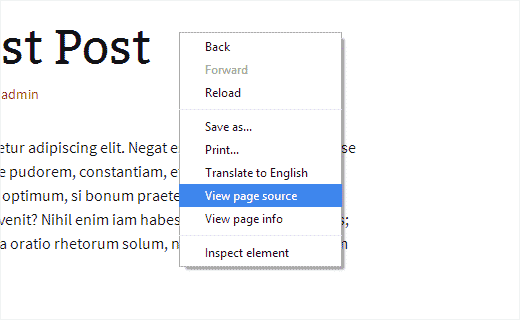
This will bring up a new tab with all the HTML code of the page.
If your link is anywhere on the page, a link tag with your URL will be in the code (e.g., “<a href=”yourURL.com”>…”).
To find it, press “ctrl + f” on this source code tab to bring up the Find tool, and type in your domain name:

If your link is on the page, you’ll get at least one match (shown above).
If your link isn’t on the page, the tool will show you 0 results:
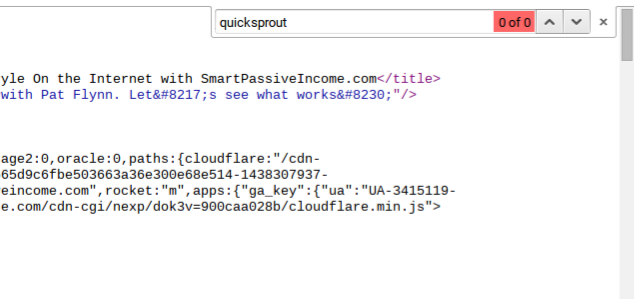
Monitoring method #2 – Check link database occasionally: The main way to find links when you don’t receive any email is to use a link database (Ahrefs, Majestic, etc.).
They won’t necessarily find all of them, but they’ll get most.
First, type in your domain name. Then hover over “Inbound Links,” and click on “New”:

You can pick how fresh you want the links to be:

If you have a free account, you’ll only be able to see a few results, so you can restrict the results to “Yesterday” or “7 days” so that there aren’t too many.
Continue to scroll down that page, and look to see if any of the new links match the sites you have sent your emails to:

If you see one, mark it down on your spreadsheet.
Track your time, and calculate ROI: Like with any link building strategy, you should track your return on investment (ROI).
With broken link building, you won’t be spending too much directly, but you will be spending your time, which has value.
ROI = (# of links) / (time spent * hourly rate)
This formula will give you a result in links per dollar spent. You can also invert it (flip it) to get a cost per link. In general, any high quality link under $100 is good, and under $50 is great.
The better you get at broken link building, the better your ROI will be.
Step 5 (Optional): Power up your results – Combine broken link building with other tactics
The most powerful thing you can take from broken link building is that it can be incorporated as part of a bigger link building strategy.
Pointing out broken links is your entry point for a relationship with a site owner. You don’t necessarily have to ask for a link on that page if you have a better alternative.
Start reading about other link building tactics to see if you can combine broken link building with one of them.
For example, broken link building can just about double your success rate with the Skyscraper technique. Not only do you have an amazing piece of content to pitch, but if you’re pointing out broken links, you’re adding even more value (always a good thing).
Conclusion
Broken link building is a powerful scalable tactic you can use to get high quality links in almost any niche.
I’ll warn you, however: it will take some trial and error the first few times you use it, but once you get efficient with it, it’s a great weapon to have in your SEO arsenal.
Decide how you’re going to incorporate broken link building into your overall SEO strategy, and then give it a try.
